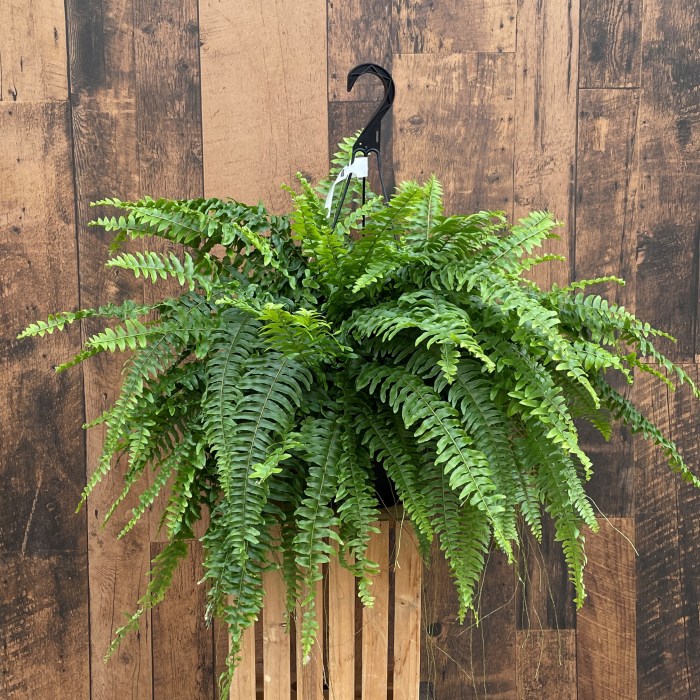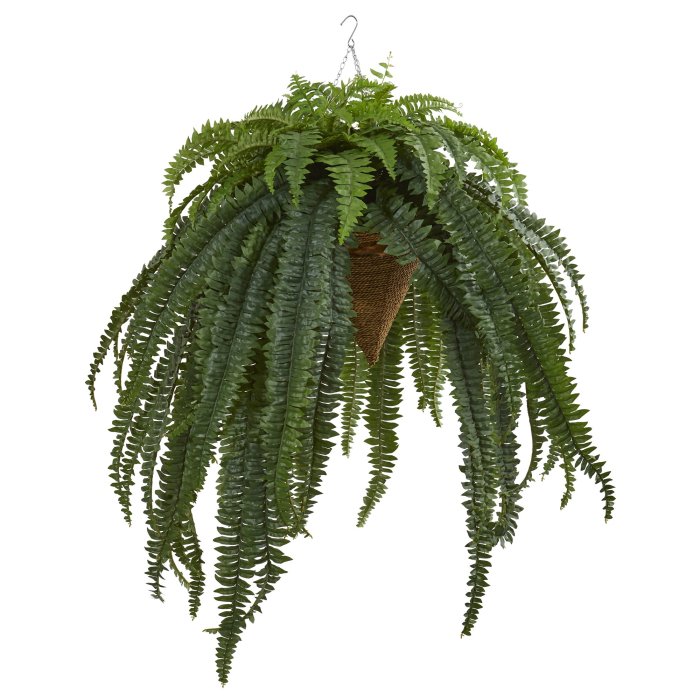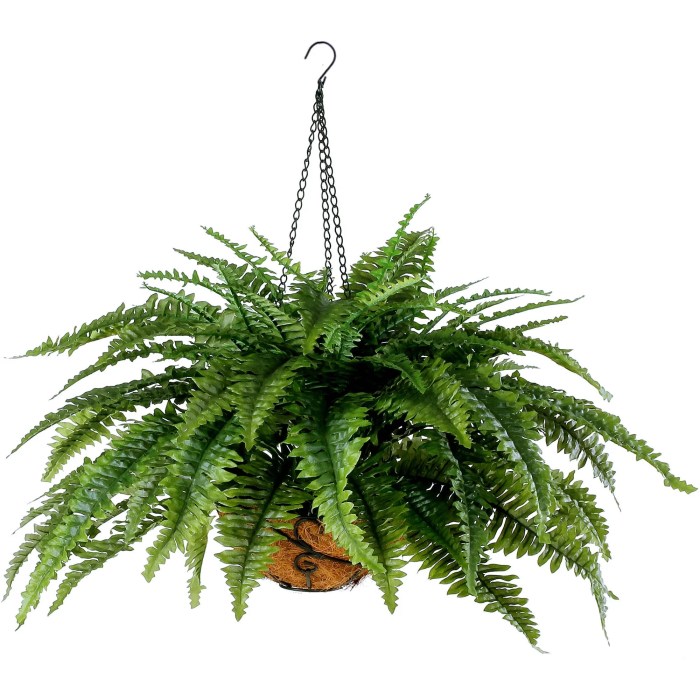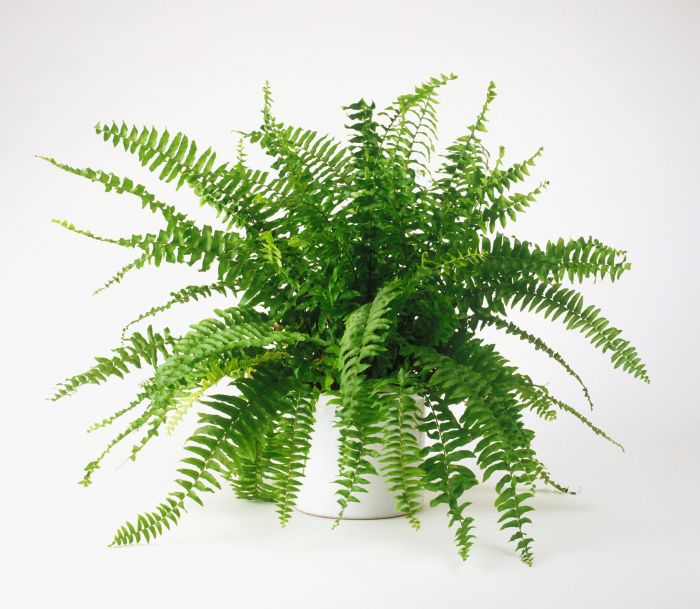Hanging boston fern indoors – Embark on a journey into the world of hanging Boston ferns indoors, where verdant fronds cascade gracefully, purifying the air and creating a tranquil ambiance. This comprehensive guide unveils the secrets to nurturing and showcasing these botanical wonders, transforming your living spaces into lush havens.
Discover the optimal care regimen for thriving Boston ferns, including watering techniques, fertilization schedules, and pruning practices. Delve into the intricacies of lighting requirements and learn how to recreate their natural habitat indoors. Explore creative display ideas, from macrame hangers to DIY planters, and find inspiration for incorporating these elegant plants into various room designs.
Indoor Hanging Boston Fern Care Guide

Watering
Boston ferns prefer moist soil, but not soggy. Water your fern when the top inch of soil feels dry to the touch. Avoid overwatering, as this can lead to root rot. If you’re unsure whether your fern needs water, it’s best to err on the side of caution and wait a few more days.
Fertilizing
Boston ferns benefit from regular fertilization. Fertilize your fern every two weeks during the growing season (spring and summer) with a balanced liquid fertilizer. Reduce fertilization to once a month during the winter months.
Pruning
Boston ferns can become leggy and overgrown if they are not pruned regularly. Prune your fern by removing any dead or dying fronds. You can also trim back any fronds that are too long or unruly. Pruning will encourage your fern to produce new growth and keep it looking its best.
Hanging Boston ferns are a popular choice for indoor greenery, known for their graceful fronds that cascade downwards. For a unique twist, consider displaying them as a draping shelf plant, creating a stunning focal point. Draping shelf plants add an element of vertical interest to any room, and the Boston fern’s lush foliage will add a touch of nature to your space.
Lighting
Boston ferns prefer bright, indirect light. Avoid placing your fern in direct sunlight, as this can scorch the leaves. If you don’t have a bright enough spot for your fern, you can supplement with artificial light.
Pests and Diseases
Boston ferns are susceptible to a few common pests and diseases. These include aphids, mealybugs, spider mites, and whiteflies. You can treat these pests with insecticidal soap or neem oil. Boston ferns can also be affected by fungal diseases such as botrytis and powdery mildew.
You can treat these diseases with a fungicide.
Choosing the Right Pot and Soil for a Hanging Boston Fern: Hanging Boston Fern Indoors

Selecting the appropriate pot and soil is crucial for the thriving of a hanging Boston fern. The ideal pot should provide ample space for root growth and ensure proper drainage.
Pot Size and Material
For a hanging Boston fern, a pot with a diameter of 10-12 inches is recommended. The material of the pot should be breathable and lightweight, such as terracotta or plastic. Terracotta pots allow for better airflow and moisture evaporation, preventing root rot.
Plastic pots are lightweight and affordable but may not provide the same level of breathability.
Hanging Boston ferns are an excellent choice for adding a touch of greenery to indoor spaces, especially those with limited natural light. These ferns thrive in shaded areas and can be easily suspended from ceilings or walls. For those seeking a wider variety of full shade indoor hanging plants, a comprehensive guide can be found at full shade indoor hanging plants . Returning to the topic of hanging Boston ferns, their trailing foliage and air-purifying qualities make them a popular choice for indoor decoration, bringing both aesthetic appeal and health benefits to any room.
Potting Mix
The potting mix should be well-draining and rich in organic matter. A mixture of peat moss, perlite, and vermiculite is an excellent option. Peat moss provides moisture retention, perlite improves drainage, and vermiculite aerates the soil. The potting mix should be slightly acidic, with a pH between 5.5 and 6.5.
Drainage
Adequate drainage is essential to prevent waterlogging, which can lead to root rot. The pot should have multiple drainage holes at the bottom to allow excess water to drain out. If the pot does not have drainage holes, it is advisable to drill some before planting the fern.
Creative Display Ideas for Hanging Boston Ferns

Hanging Boston ferns add a touch of elegance and greenery to any indoor space. Here are some creative ideas to showcase these beautiful plants:
Macrame Hangers:Macrame hangers are a stylish and bohemian way to display hanging Boston ferns. You can purchase macrame hangers in various styles and sizes or create your own using macrame cord.
Plant Shelves:Plant shelves are a great way to display multiple hanging Boston ferns at different heights. You can find plant shelves in various materials, such as wood, metal, and plastic.
Hanging Boston ferns are a popular choice for indoor spaces, adding a touch of greenery and elegance. They are known for their long, trailing fronds that cascade beautifully from hanging baskets. If you’re looking for the easiest hanging houseplants to care for, be sure to consider Boston ferns.
They are relatively low-maintenance, requiring only moderate watering and occasional fertilization. For a comprehensive guide to the easiest hanging houseplants, visit easiest hanging houseplants for more information and recommendations. Hanging Boston ferns are a great option for both experienced and novice plant owners, making them a versatile choice for any indoor space.
Hanging Baskets:Hanging baskets are a classic way to display hanging Boston ferns. You can use wire baskets, wicker baskets, or ceramic baskets.
DIY Hanging Planter, Hanging boston fern indoors
To create a DIY hanging planter for your Boston fern, you will need the following materials:
- A piece of wood or bamboo
- A drill
- A saw
- A piece of twine or rope
- A pot for your Boston fern
Instructions:
- Cut a piece of wood or bamboo to the desired length. The length will depend on how long you want your hanging planter to be.
- Drill a hole in each end of the wood or bamboo.
- Cut a piece of twine or rope to the desired length. The length will depend on how high you want your hanging planter to hang.
- Thread the twine or rope through the holes in the wood or bamboo.
- Tie the ends of the twine or rope together to create a loop.
- Place the pot for your Boston fern inside the loop.
Incorporating Hanging Boston Ferns into Room Designs
Hanging Boston ferns can be incorporated into various room designs and styles. Here are a few ideas:
- In a living room, hanging Boston ferns can add a touch of greenery and elegance. They can be hung from the ceiling, from a plant shelf, or from a macrame hanger.
- In a kitchen, hanging Boston ferns can add a touch of freshness and life. They can be hung from the ceiling, from a plant shelf, or from a hanging basket.
- In a bedroom, hanging Boston ferns can add a touch of peace and tranquility. They can be hung from the ceiling, from a plant shelf, or from a macrame hanger.
Troubleshooting Common Problems with Hanging Boston Ferns

Hanging Boston ferns are generally low-maintenance plants, but they can occasionally develop problems. Here are some common issues and how to resolve them:
Yellowing Leaves
Yellowing leaves can indicate several problems.
- Overwatering: Boston ferns prefer moist soil but not soggy soil. Overwatering can lead to root rot, which causes leaves to turn yellow and drop.
- Underwatering: If the soil is too dry, the leaves will also turn yellow and wilt.
- Nutrient deficiency: A lack of nitrogen can also cause yellowing leaves. Fertilize the fern monthly during the growing season with a balanced fertilizer.
Brown Tips
Brown tips on the leaves can be caused by:
- Low humidity: Boston ferns prefer high humidity. If the air is too dry, the tips of the leaves will turn brown and crispy.
- Fertilizer burn: Using too much fertilizer can burn the roots and cause the tips of the leaves to turn brown.
- Fluoride toxicity: Boston ferns are sensitive to fluoride, which can be found in some tap water. If you use tap water to water your fern, let it sit out for 24 hours before watering to allow the fluoride to evaporate.
Stunted Growth
Stunted growth can be caused by:
- Lack of light: Boston ferns need bright indirect light to grow properly. If the plant is not getting enough light, it will stop growing and the leaves will become smaller.
- Rootbound: If the fern is rootbound, it will not be able to absorb enough nutrients and water to grow properly. Repot the fern in a larger pot with fresh potting mix.
Benefits of Hanging Boston Ferns Indoors

Hanging Boston ferns are not only aesthetically pleasing but also provide numerous benefits for indoor environments.
Air Purification
Boston ferns are known for their ability to purify the air. Studies have shown that they can effectively remove harmful toxins such as formaldehyde, xylene, and benzene from the air. These toxins are commonly found in household products, building materials, and cleaning agents.
Stress Reduction
The presence of plants in indoor spaces has been linked to reduced stress levels and improved mood. Boston ferns, with their lush foliage and graceful appearance, can create a sense of tranquility and relaxation in a room.
Improved Sleep
Boston ferns can also help improve sleep quality. The release of oxygen and removal of toxins from the air can create a more conducive environment for restful sleep.
Concluding Remarks

Hanging Boston ferns stand as living testaments to the power of nature to enhance our well-being. Their air-purifying abilities contribute to a healthier indoor environment, while their graceful presence evokes a sense of serenity and relaxation. Embrace the beauty and benefits of these indoor wonders, and transform your living spaces into verdant oases.
Expert Answers
How often should I water a hanging Boston fern?
Water thoroughly when the soil surface feels dry to the touch, typically every 1-2 weeks.
What is the best lighting for a hanging Boston fern?
Bright, indirect light is ideal, such as near an east- or north-facing window.
How do I prevent brown tips on my hanging Boston fern?
Ensure adequate humidity by misting regularly or using a humidifier. Overwatering can also contribute to brown tips.